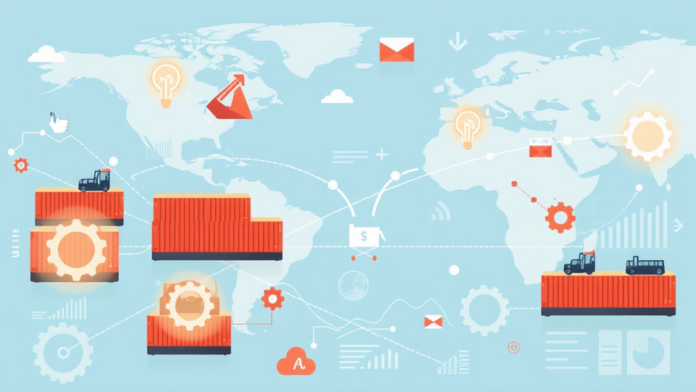Introduction to Global Supply Chain Disruptions
Definition and Overview
Global supply chain disruptions refer to significant interruptions in the flow of goods and services across international borders. These disruptions can arise from various factors, including natural disasters, geopolitical tensions, and pandemics. Such events can severely impact businesses, leading to delays and increased costs . It’s crucial to understand these dynamics.
When supply chains are disrupted, companies may struggle to meet customer demand. This can result in lost revenue and diminished customer trust. Every business should be prepared for these challenges. The financial implications can be profound, affecting cash flow and profitability. It’s a wake-up call for many organizations.
Moreover, these disruptions can lead to a reevaluation of sourcing strategies. Companies may seek to diversify their suppliers to mitigate risks. This is a smart move in today’s volatile environment. Understanding the broader economic landscape is essential for effective decision-making. Knowledge is power in business.
Historical Context of Supply Chain Issues
Historically, supply chain issues have emerged from various global events that disrupted trade and logistics. For instance, the oil crisis of the 1970s caused significant delays in transportation and increased costs for many industries. This was a pivotal moment for businesses. Similarly, the 2008 financial crisis highlighted vulnerabilities in global supply networks. Many companies faced bankruptcy due to their reliance on single suppliers. It was a harsh lesson in risk management.
In recent years, natural disasters have also played a critical role in supply chain disruptions. Events like hurricanes and earthquakes can halt production and transportation for extended periods. These incidents remind us of nature’s unpredictability. Additionally, geopolitical tensions, such as trade wars, have further complicated international trade. Companies must navigate these complexities carefully.
Moreover, the COVID-19 pandemic has underscored the fragility of global supply chains. Lockdowns and restrictions led to widespread shortages of essential goods. This situation has prompted many businesses to rethink their strategies. Adaptation is key in a changing world. Understanding these historical contexts is vital for effective planning. Knowledge shapes better decisions.
Recent Events Triggering Disruptions
Recent events have significantly impacted global supply chains, leading to widespread disruptions. For example, the COVID-19 pandemic caused unprecedented shutdowns across various industries. Many businesses struggled to maintain operations during this period. This situation highlighted vulnerabilities in existing supply networks.
Additionally, geopolitical tensions, sucb as trade disputes between major economies, have created uncertainty. These tensions often result in tariffs and restrictions that complicate trade. Companies must adapt quickly to these changes. Furthermore, natural disasters, including hurricanes and wildfires, have disrupted logistics and production. Such events can halt operations for days or weeks.
Moreover, the semiconductor shortage has affected numerous sectors, particularly electronics and automotive industries. This shortage has delayed production timelines and increased costs. He must consider these factors when planning. Supply chain resilience is now more critical than ever. Understanding these recent events is essential for effective risk management. Knowledge empowers better decision-making.
Impact on Businesses
Operational Challenges
Operational challenges arising from supply chain disruptions can significantly affect businesses. These challenges often manifest in various ways, including increased costs, delayed deliveries, and reduced product availability. Companies may face the following issues:
Moreover, businesses may demand to invest in technology to enhance supply chain visibility . Implementing advanced analytics can help in forecasting demand more accurately. This is a smart strategy. Additionally, companies might consider diversifying their supplier base to mitigate risks. This approach can provide more flexibility.
Ultimately, addressing these operational challenges requires a proactive mindset. Companies must continuously assess their supply chain strategies. Adaptation is essential in a dynamic market. Understanding these impacts is crucial for maintaining competitiveness. Knowledge drives effective solutions.
Financial Implications
Financial implications of supply chain disruptions can be profound for businesses. Increased operational costs often arise from delays and inefficiencies. This can lead to reduced profit margins. Companies may also experience cash flow challenges due to inventory shortages. This situation can strain financial resources.
Moreover, businesses may need to invest in alternative suppliers, which can incur additional expenses. These costs can accumulate quickly. In some cases, companies might face penalties for failing to meet contractual obligations. This can further impact their financial standing.
Additionally, the need for technology investments to enhance supply chain visibility can strain budgets. Implementing advanced systems requires upfront capital. However, these investments can yield long-term benefits. Understanding these financial implications is essential for strategic planning. Knowledge is crucial for informed decision-making.
Strategic Adjustments Required
Strategic adjustments are essential for businesses facing supply chain disruptions. Companies must reassess their sourcing strategies to enhance resilience. This may involve diversifying suppliers to mitigate risks associated with single-source dependencies. A broader supplier base can provide more flexibility.
Additionally, businesses should invest in technology to improve supply chain visibility. Implementing real-time tracking systems can facilitate better decision-making. This is a critical step for operational efficiency. Furthermore, companies may need to adopt just-in-time inventory practices to reduce holding costs. This approach can optimize cash flow.
Moreover, organizations should consider developing contingency plans for potential disruptions. These plans can outline alternative sourcing and logistics strategies. Preparedness is key in a volatile environment. Training employees on these strategies can also enhance responsiveness. Knowledge empowers teams to act swiftly.
Ultimately, adapting to these challenges requires a proactive mindset. Companies must continuously evaluate their strategies to remain competitive. Understanding the need for strategic adjustments is vital for long-term success.
Risk Management Strategies
Diversification of Supply Sources
Diversification of supply sources is a critical risk management strategy for businesses. By sourcing materials from multiple suppliers, companies can reduce their dependence on any single source. This approach minimizes the impact of disruptions caused by geopolitical issues or natural disasters. It is a prudent strategy.
Furthermore, diversifying suppliers can enhance competitive advantage. Companies can negotiate better terms and prices when they have options. This flexibility can leqd to cost savings. Additionally, businesses should consider geographic diversification. Sourcing from different regions can protect against localized disruptions. This is a smart move.
Moreover, establishing relationships with alternative suppliers can improve responsiveness during crises. Companies that have pre-existing agreements can quickly pivot when issues arise. This readiness can significantly reduce downtime. It is essential to evaluate potential suppliers based on reliability and quality. A thorough assessment is necessary.
Finally, businesses should continuously monitor their supply chain landscape. Regular evaluations can identify emerging risks and opportunities. Staying informed is crucial for effective decision-making. Knowledge is power in supply chain management.
Investment in Technology and Automation
Investment in technology and automation is essential for effective risk management in supply chains. Advanced technologies can enhance visibility and control over operations. This leads to better decision-making. Companies can utilize data analytics to forecast demand accurately. Accurate forecasts can prevent stockouts and overstock situations.
Moreover, automation can streamline processes, reducing human error. Automated systems can handle repetitive tasks efficiently. This increases productivity and allows employees to focus on strategic initiatives. Implementing robotics in warehousing can significantly speed up order fulfillment. Speed is crucial in today’s market.
Additionally, integrating supply chain management software can provide real-time insights. These insights enable companies to respond swiftly to disruptions. A proactive approach is vital for maintaining operational continuity. Investing in cybersecurity measures is also critical. Protecting sensitive data is non-negotiable.
Finally, businesses should continuously evaluate their technology investments. Regular assessments can identify areas for improvement. Staying updated with technological advancements is necessary. Knowledge drives competitive advantage.
Building Resilience in Supply Chains
Building resilience in supply chains is crucial for mitigating risks. Companies must develop flexible strategies to adapt to unforeseen disruptions. This flexibility allows for quick responses to changing circumstances. A resilient supply chain can maintain operations during crises. This is essential for long-term success.
One effective approach is to establish strong relationships with multiple suppliers. By diversifying sources, businesses can reduce dependency on any single supplier. This strategy minimizes the impact of localized disruptions. Additionally, companies should invest in training employees to handle unexpected challenges. Prepared teams can respond more effectively.
Moreover, conducting regular risk assessments can key vulnerabilities within the supply chain. Understanding potential risks enables proactive planning. Companies can implement contingency plans to address these risks. This foresight is invaluable in maintaining continuity.
Finally, leveraging technology can enhance supply chain resilience. Advanced analytics can provide insights into potential disruptions. This information allows for informed decision-making. Knowledge is key to navigating uncertainties.
Future Outlook and Recommendations
Trends in Global Supply Chains
Trends in global supply chains indicate a shift towards greater sustainability and digitalization. Companies are increasingly prioritizing environmentally friendly practices. This focus can enhance brand reputation. Additionally, the integration of advanced technologies is becoming essential. Automation and artificial intelligence streamline operations effectively.
Moreover, nearshoring is gaining traction as businesses seek to reduce risks associated with long-distance supply chains. By relocating production closer to end markets, companies can improve responsiveness. This strategy can also lower transportation costs. Furthermore, data analytics is playing a pivotal role in supply chain optimization. Real-time insights enable better decision-making.
Another trend is the emphasis on supply chain transparency. Stakeholders demand visibility into sourcing and production processes. This transparency fosters trust and accountability. Companies that embrace this trend can differentiate themselves in the market.
Finally, collaboration among supply chain partners is becoming increasingly important. Strategic alliances can enhance resilience and innovation. Working together can lead to shared resources and knowledge. This is a powerful approach.
Policy Recommendations for Businesses
Policy recommendations for businesses should focus on enhancing supply chain resilience. He must prioritize diversification of suppliers to mitigate risks. This strategy reduces dependency on single sources. Additionally, investing in technology is crucial for improving operational efficiency. Automation can streamline processes and reduce costs.
Furthermore, companies should implement robust risk management frameworks. Regular assessments can identify vulnerabilities within the supply chain. This proactive approach allows for timely interventions. He should also foster collaboration with supply chain partners. Strong relationships can enhance information sharing and innovation.
Moreover, businesses must emphasize sustainability in their operations. Adopting environmentally friendly practices can improve brand image. This is increasingly important to consumers. Transparency in sourcing and production processes is also essential. Stakeholders expect visibility into eupply chain practices.
Finally, continuous training and development of employees are vital. Knowledgeable staff can adapt to changing market conditions. Investing in human capital is a smart move. Understanding these policy recommendations is key for long-term success. Knowledge drives better decision-making.
Conclusion and Final Thoughts
In navigating the complexities of global supply chains, businesses must adopt a forward-thinking approach. Emphasizing resilience and adaptability is essential for long-term success. Companies should prioritize diversification of suppliers to mitigate risks associated with disruptions. This strategy can enhance operational stableness.
Moreover, investing in technology and automation is crucial . Advanced systems can provide real-time insights and improve efficiency. This leads to better decision-making and resource allocation. Additionally, fostering strong relationships with supply chain partners can facilitate collaboration and innovation. Working together can yield significant benefits.
Furthermore, sustainability should be at the forefront of business strategies. Consumers increasingly value environmentally responsible practices. Companies that prioritize sustainability can enhance their brand reputation. Transparency in operations is also vital. Stakeholders expect clarity regarding sourcing and production processes.
Finally, continuous training and development of employees are necessary. A knowledgeable workforce can adapt to changing market dynamics. Investing in human capital is a strategic advantage. Understanding these elements will empower businesses to thrive in an evolving landscape. Knowledge is the foundation of effective strategies.

